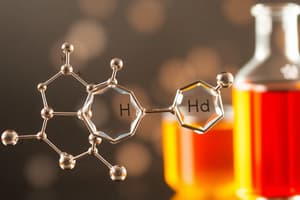Podcast
Questions and Answers
Apa yang menjadi ciri fisik dari asam karboksilat?
Apa yang menjadi ciri fisik dari asam karboksilat?
Titik didih yang tinggi, kelarutan dalam air dan pelarut polar, serta karakter ionik.
Jelaskan mengapa asam karboksilat memiliki titik didih yang tinggi dibandingkan dengan alkohol sebanding lainnya?
Jelaskan mengapa asam karboksilat memiliki titik didih yang tinggi dibandingkan dengan alkohol sebanding lainnya?
Asam karboksilat memiliki titik didih yang tinggi karena adanya gugus karbonil yang meningkatkan gaya tarik antarmolekul.
Apa reaksi utama yang dapat terjadi pada asam karboksilat?
Apa reaksi utama yang dapat terjadi pada asam karboksilat?
Reaksi sifat asam, di mana asam karboksilat dapat berperan sebagai donor proton.
Bagaimana sifat asam karboksilat berkontribusi terhadap karakter ioniknya?
Bagaimana sifat asam karboksilat berkontribusi terhadap karakter ioniknya?
Mengapa asam karboksilat bisa mengkristal jika konsentrasinya terlalu tinggi dalam larutan?
Mengapa asam karboksilat bisa mengkristal jika konsentrasinya terlalu tinggi dalam larutan?
Apa yang terjadi saat nukleofil seperti ion halida atau alkoksida menggantikan atom oksigen karbonil?
Apa yang terjadi saat nukleofil seperti ion halida atau alkoksida menggantikan atom oksigen karbonil?
Bagaimana ester terbentuk dalam reaksi esterifikasi?
Bagaimana ester terbentuk dalam reaksi esterifikasi?
Bagaimana pembentukan amida terjadi?
Bagaimana pembentukan amida terjadi?
Berikan contoh metode sintesis karboksilat yang melibatkan oksidasi alkohol.
Berikan contoh metode sintesis karboksilat yang melibatkan oksidasi alkohol.
Apa yang terjadi dalam reaksi Friedel-Crafts Acetylation?
Apa yang terjadi dalam reaksi Friedel-Crafts Acetylation?
Flashcards are hidden until you start studying
Study Notes
Carboxylic Acids Overview
Carboxylic acids are organic compounds featuring a carboxyl functional group (-COOH) consisting of a carbonyl group connected to a hydroxyl group through a carbon atom. They are one of the most common classes of organic molecules and play crucial roles in numerous biological processes. In this article, we will discuss the properties, reactions, and synthesis of carboxylic acids.
Physical Properties of Carboxylic Acids
The physical properties of carboxylic acids can vary depending on their size and structure. Some general properties include:
- Boiling Points: Carboxylic acids generally have higher boiling points compared to other comparable alcohols due to the presence of the carbonyl group.
- Solubility: These acids are soluble in both water and polar solvents like ethanol and diethyl ether. However, they may crystallize out of solution if the concentration is too high.
- Ionic Character: Although carboxylic acids do not dissociate completely into ions when dissolved in water, there is still some ionic character present, which contributes to their acidity.
Reactions of Carboxylic Acids
Carboxylic acids undergo various chemical reactions due to the reactivity of the carboxyl group. Here are some key reactions:
- Acidic Properties: Due to the ionizable hydrogen atom attached to the oxygen in the carboxyl group, carboxylic acids exhibit acidic behavior and can act as proton donors.
- Nucleophilic Substitution: Nucleophiles such as halide ions or alkoxides can replace the carbonyl's oxygen atom, leading to nucleophilic substitution reactions.
- Esterification: When carboxylic acids react with alcohols in the presence of a catalyst like sulfuric acid, esters are formed; these reactions take place between the hydroxyl group of the alcohol and the carbonyl group of the carboxylic acid.
- Amide Formation: Amine groups can also react with carboxylic acids to form amides via nucleophilic attack, again taking place between the lone pair electrons on nitrogen and the electrophilic carbonyl group.
Synthesis of Carboxylic Acids
There are several methods for synthesizing carboxylic acids, including:
- Oxidation of Alcohols: Oxidation using reagents like potassium permanganate (KMnO₄), chromic oxide (CrO₃), or hydrogen peroxide (H₂O₂) can convert primary or secondary alcohols into corresponding carboxylic acids.
- Friedel-Crafts Acetylation: This reaction involves treating aromatic compounds with acetic anhydride in the presence of a Lewis acid catalyst, resulting in the formation of phenylacetates that can later be converted to carboxylic acids upon treatment with hydrochloric acid (HCl).
- Acyl Chloride Hydrolysis: Acyl chlorides (RCOCl) react with sodium hydroxide (NaOH) solutions to produce carboxylic acids and sodium salts. Afterward, the sodium salt is treated with a mineral acid like sulfuric acid (H₂SO₄) to yield the free carboxylic acid.
In summary, carboxylic acids are essential components of many natural products and serve as versatile intermediates in synthetic chemistry due to their diverse range of reactions and methods for synthesis. Understanding the properties and reactions of carboxylic acids is crucial for chemists working in fields ranging from pharmaceuticals to materials science.
Studying That Suits You
Use AI to generate personalized quizzes and flashcards to suit your learning preferences.




